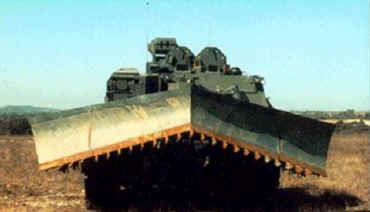Frontal shields are valuable for all light armored
combat vehicles. They would normally ride a few inches from the surface, but
could be lowered to the ground if
needed. The driver could control their height depending on the terrain with hydraulic
lifts like those used on some M113 APCs (below).
They should be V-shaped, like those on the new M1 Grizzly engineer vehicle (below) to push debris and roadblocks out of the way. In past wars, obstacles in tight urban areas often impeded the advance of armored vehicles. V-shaped shields also allow vehicles to easily knock down doors and walls. The shield may have a row of sharp "hedgehog" teeth to cut through brush, like those improvised by Americans during the 1944 Normandy fighting. Shields could also be used to clear brush for helicopter landing zones or around defensive positions, and clear roads in urban areas of minor debris so trucks can move forward.
The blade should have a smooth metal bottom so it can slide along the ground like a sled, allowing it to detonate small anti-personnel mines, unexploded submunitions, and booby traps. A common hasty defense tactic is to place place mines on hard surface roads and cover them with sniper fire. This stops vehicles, and foot soldiers attempting to remove the mines face gunfire. A vehicle with a shield could just push them aside. Engineer vehicles are better designed for such tasks, but they are not always available, and rapidly clearing hazards off roads is essential to protect infantrymen and wheeled vehicles. Land mines destroyed most armored vehicles during the Vietnam war, but newer designs ignore this problem. The shield should weigh well over 300lbs, so it would also detonate larger anti-tank mines encountered during combat. This would mangle the shield, but leave the vehicle untouched.
 The
best
value of the shield would be for protection from direct frontal fire using the concept of armor
spacing. Anti-tank shaped warheads would explode and punch a
hole though the angled shield, as would 20-40mm gun fire. However, most of
the explosive force would dissipate before it struck the light hull armor two feet
behind. This would not stop most tank rounds and larger anti-armor missiles,
but would afford far more protection than any light armored vehicle in service
today. This requires the shield to be taller and thicker than those
pictured here, which may pose problems for the driver. However, new
vehicles are equipped with tiny remote cameras and flat screen viewers which
provide drivers with excellent awareness when his direct view is blocked.
The
best
value of the shield would be for protection from direct frontal fire using the concept of armor
spacing. Anti-tank shaped warheads would explode and punch a
hole though the angled shield, as would 20-40mm gun fire. However, most of
the explosive force would dissipate before it struck the light hull armor two feet
behind. This would not stop most tank rounds and larger anti-armor missiles,
but would afford far more protection than any light armored vehicle in service
today. This requires the shield to be taller and thicker than those
pictured here, which may pose problems for the driver. However, new
vehicles are equipped with tiny remote cameras and flat screen viewers which
provide drivers with excellent awareness when his direct view is blocked.
Shields are essential to protect tires of wheeled armored vehicles. Enemy infantrymen will aim at rubber tires and quickly fill them with holes. Modern APCs with rubber wheels advertise themselves as "run flat" since they are filled with foam or have an air compressor to keep the tires filled with air. However, if a tire is riddled with bullets it will come apart. Even just a few holes present operational problems because stopping to change tires after each skirmish becomes tiresome, especially as a spare tire shortage quickly develops. Watching a wheeled or track vehicle drive through barbed or concertina war is fun to watch. It doesn't stop them, but wire usually becomes tangled around the wheels and tracks causing numerous minor problems. A vehicle equipped with a shield could rip a clean path through.
Poor roads often hamper operations as trucks and other vehicles become bogged down in snow or shell holes. Engineers are tasked with these mobility missions, but they may not arrive for hours. Vehicles with shields could fix many road problems, and would also be effective in crowd control. Infrared detection is also a "hot" issue since vehicles produce large signatures as the engine heat transfers throughout the body and the tracks generate their own heat through friction. Since a shield would hang two feet in front, it could block maybe 75% of a vehicles infrared signature. Shields would become a life saver in a serious war, so armies should carry plenty of shields to replace those wrecked by enemy fire and mines. There are numerous advantages to shields, but their ability to detonate simple RPG rounds prematurely is what makes them revolutionary for ground combat.
Carlton Meyer editorG2mil@Gmail.com
©2001 www.G2mil.com